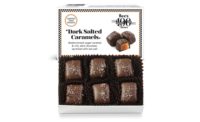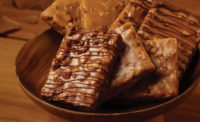Caramel boasts a long tradition.
“The basic caramel flavor has been a staple of the candy industry since the beginning,” says Charlie Douglass, chocolatier, Harry & David.
That’s probably because caramel has plenty of positive attributes that make it easy to use. It’s incredibly versatile, with a vast range in flavor and texture depending on how it’s made and the ingredients used in its creation.
According to Elliott Callahan, master chocolatier at Fannie May, the amount of butter, type of milk and type of sugar used can create nuances in flavor, while cooking temperature can affect firmness. That versatility means every candy maker can create unique caramel products.
“It has such a comforting quality to it while at the same time evoking nostalgic memories in most folks that eat it,” says Jerrod Smith, founder and owner, Shotwell Candy Co.
Caramel appeals to consumers’ sentimentality. It also satisfies their desire for convenience. Caramel that is not enrobed in chocolate is extremely easy to ship, making it easy to order online.
“In the e-commerce world in which we live today, ship-ability (and cost of transportation) is playing an increasingly important role in customer decision-making,” says Smith.
All of these desirable attributes come together to create a constant appetite within the industry for caramel.
“As a flavor, caramel is perennial in nature, never going away and being rediscovered by new generations,” says Douglass.
Consistent demand naturally leads to innovations. Caramel is becoming more mainstream, causing it to be used in combination with many different snacks to satisfy consumer demand, says Mia Bongiovanni, original brand manager, Werther’s.
In fact, caramel, taffy apples, kits and dips collectively generated more than $87 million in sales this past year, and dollar sales are up 2.87 percent, according to the latest data from IRI, a Chicago-based research firm.
“We believe caramel has incredible potential to satisfy various eating occasions and consumer need states,” says Bongiovanni. “One of our recent innovations capitalizes on the rising trend in consumer snacking - Werther’s Original Caramel Popcorn - bringing Werther’s quality caramel to a classic treat.”
Caramel makes a great pairing with a variety of different tastes and textures. And the richness and complexity of its flavors, which Douglass compares to those of wine and coffee, make it easy to work with.
Fannie May has already paired caramel with apples and marshmallows, but there’s more on the horizon.
“We expect to see pairings with healthier inclusions like seeds, nuts and dried fruits,” says Callahan. “We also anticipate more ‘artisan’ manufacturing of caramel.”
Companies like Smith’s Shotwell Candy Co. are part of that movement, creating small-batch caramel products that have been gaining interest and popularity since the company opened in 2012. Smith has also created caramel treats that capture the flavors of fall, using bourbon, fresh-roasted pecans and pure maple syrup.
“The care and effort put into creating small-batch confections like our caramels is immediately present to those tasting our candy, and I think people really are gravitating to products that exude authenticity,” says Smith.
He also sees two trends continuing to grow: unique sweet and savory flavor combinations, and cocktail-based flavor combinations.
“Spice or other savory items are a perfect foil for the very sweet caramel base that keeps a customer’s palate from being bored with a simple sweet piece of candy,” Smith says.
Apart from the already-popular combination of caramel and sea salt, companies like Harry & David are working to combine maple, cinnamon and pecans to form a new flavor. The Popcorn Factory has also expanded its caramel popcorn line to include flavors like Pumpkin Caramel Praline.
As for the cocktail-based flavors, Smith says caramel stands up well in the company of spirits.
Tapping into the emotional connection customers have with their favorite cocktails creates an immediate, positive mental experience, he says, even before they take a bite of the caramel. Evoking memories of a Mai Tai at the beach or an Old Fashioned with friends in a bar can help tap into the nostalgia that people feel and then associate it with eating caramel.
“There are some brilliant bar tenders out there who have created hundreds of cocktails (most of which have a sweet component) that translate very well into confections,” says Smith.
And in some cases, the spirit addition can be added to another inclusion. Shotwell Candy Co.’s fall flavor contains both bourbon and crunchy pecans, which add texture to the caramel and liven up the eating experience.
Pecans aren’t the only popular inclusions either. Pretzels, coffee beans, nuts and granola have all been used to create combinations that are unique both in taste and in texture.
Of course, in the face of new trends, there remain companies that try to perfect the confection at its simplest form. Using natural flavors to create simple products like the pecan caramel, the Caramel Candy Co. believes that good caramel can stand alone.
Nahlee Waters, owner of the Caramel Candy Co., admits that the company may not be the most trendy. But she doesn’t see the demand for good, simple caramel dropping any time soon.
“We do everything the old-fashioned way by hand, not machines,” she says. “We are certainly not the biggest, but we hope someday to be the best.”
Hershey, too, has gotten into the traditional caramel segment, releasing the Lancaster line of soft crèmes caramels in the U.S. in 2014, and featuring the new Hershey’s Caramels at this year’s Sweets and Snacks Expo.
The new Hershey’s Caramels combine the company’s signature milk or dark chocolate with caramel, and the chocolate-covered candies contain sea salt, molasses, and dairy butter.
Hershey says the caramel pieces are wrapped up in a blanket of milk or dark chocolate for the optimal caramel-chocolate ratio. And cocoa is added to the milk chocolate for a rich, deep flavor that corresponds to the sharp sweetness of caramel. Each piece is also touch decorated for a gourmet, hand-crafted appearance.
As for the Lancaster brand, Hershey says it was meant to invoke the company’s heritage and was inspired by Milton Hershey’s original confection company, The Lancaster Caramel Co.
Lancastersoft crèmes also offer a long-lasting and unique taste experience that is distinct from the typical caramels that dominate the category. The surprisingly soft, rich and creamy Lancaster Soft Crèmes provide a modern caramel taste experience, which Hershey says it created to meet a growing consumer demand.
The brand originally included three flavors — Caramel, Vanilla and Caramel, and Vanilla and Raspberry — but this year Hershey expanded it to also include Butterscotch and Caramel.
Sounds like a sweet treat that dovetails both caramels’ long history in the confectionery company with its ever-growing popularity.











